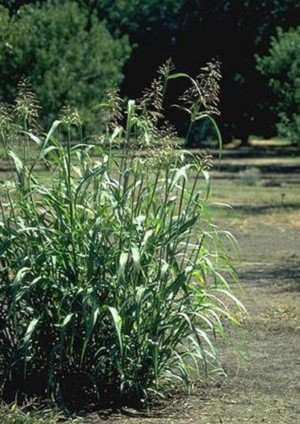Field Guide  Weed Management
Weed Management  Johnsongrass
Johnsongrass
Johnsongrass (Sorghum halepense)
Crop Impacts: Corn, cotton, soybeans and legumes
 | |
About Johnsongrass:Johnsongrass reproduces by its seeds and its rhizome root system. It is a perineal grass that starts to show in mid-May from the rhizomes and in late-May from the germination of their seeds. Family: Poaceae family 
Johnsongrass Scouting and Prevention:Johnsongrass has soft leaves with a noticeable white mid vein. They produce 3 to 5 mm long oval seeds which are dark red, brownish to almost tan or black. The entire plant can reach about 2 to 7 feet tall with slightly coarse, open, purple panicle that starts to flower in late July. Common locations- - Open areas
- - Cultivated fields
- - Corn fields
- - Cotton fields
- - Soybeans fields
- - Legumes fields
PreventionPrevention of Johnsongrass is less expensive and less time-consuming then trying to control it. Make sure when you seed a new area, you do so with certified weed-free seeds. If there is an infested area on your property, be sure to drive around instead of through it. Finally, make sure to give all equipment that has been in infested fields a good clean to make sure no seeds are transferred. Johnsongrass Control:Cultural ControlDo not panic if you find Johnsongrass in your pastures, the grazing of livestock will be able to control the plant. As for hayfields, mowing is an adequate way to manage the grass. Here are a few general suggestions to protect your crops from weeds: - - Make sure you have high-yielding varieties of plants that are adaptable
- - The field should be planted in narrow rows with high plant population as soon as ideal soil and weather conditions are met
- - Scout fields on a regular basis
- - Add in plants such as alfalfa or small grains into your crop rotation
Chemical ControlThis is a very competitive plant that requires a lot of attention so that it does not become a predominate plant. Using herbicides with glyphosate such as roundup provide an effective way to spot treat Johnsongrass; however, it may take several applications. Post-emergence herbicide products such as clethodim (Envoy), fluazifop (Fusilade II), imazapic (Plateau) or sethoxydim (Vantage) can be useful on the outlying areas of your property. Latin / Alternative Johnsongrass names:Additional Johnsongrass Resources |
http://plants.usda.gov/core/profile?symbol=SOHA
http://www.caes.uga.edu/applications/gafaces/?public=viewStory&pk_id=4858
http://extension.psu.edu/pests/weeds/control/johnsongrass-and-shattercane-control-an-integrated-approach
http://www.oisat.org/pests/weeds/grasses/johnsongrass.html